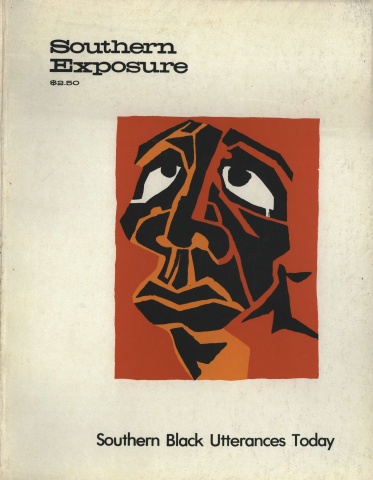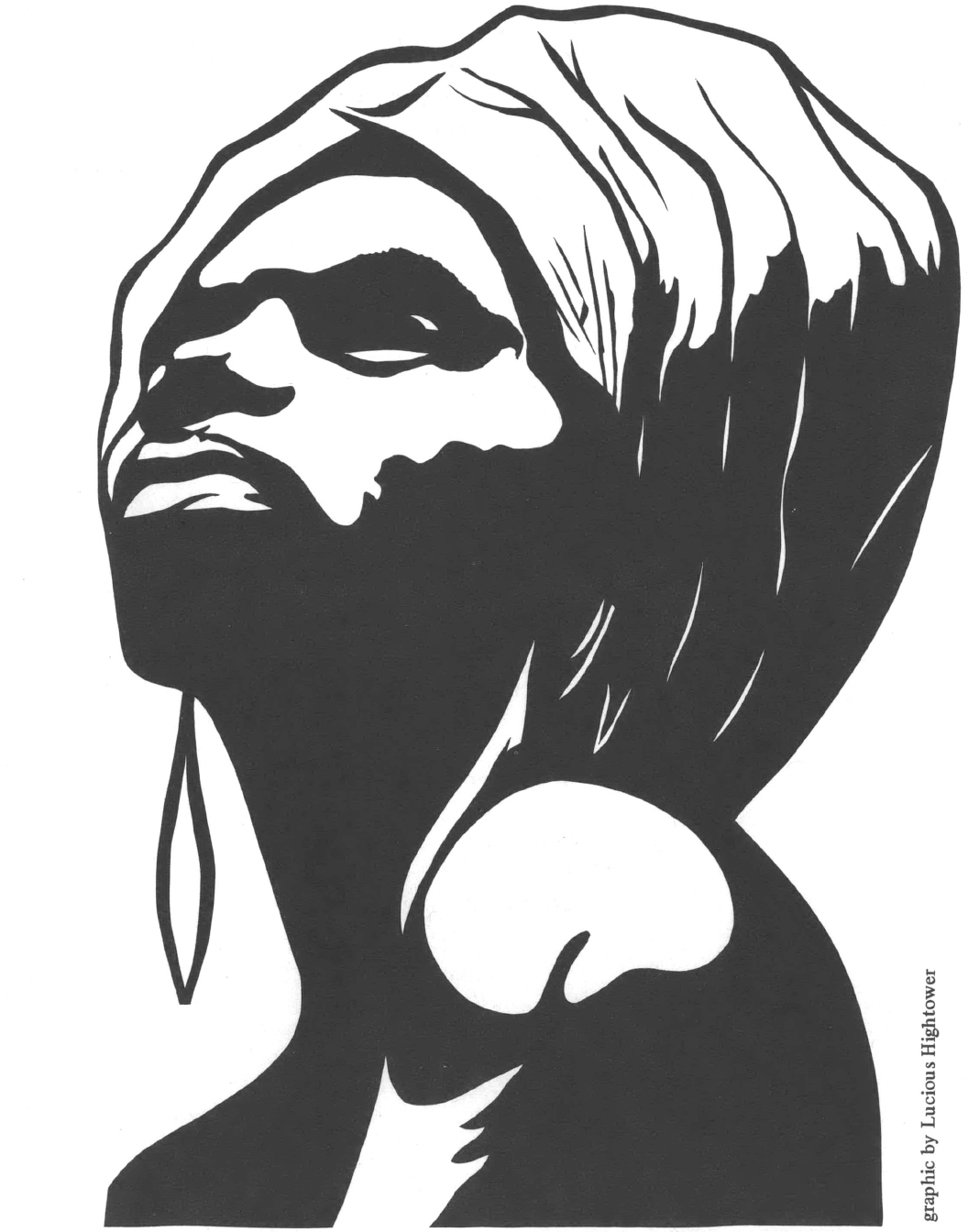
This article originally appeared in Southern Exposure Vol. 3 No. 1, "Southern Black Utterances Today." Find more from that issue here.
"Hail, Hail America: What's gonna happen to you? . . . What's gonna be the fad next year.. .?"* These questions raised by Zulema, a Black singer, are well suited to artistic concerns, especially those relating to images that shape and herald new "fads" in the literary and plastic arts. The death of some of the most damaging fads, i.e., stereotyped images of Black women, has been long in coming. But an iconoclastic effort to speed up the process —to tear down the old images and replace them with positive, realistic ones —is located in an unpublished anthology we have prepared titled Positive images of Black Women.
Libraries, bookstores, art galleries and movie theaters are saturated with distorted images of Black women: respected and domineering servants; dynamic and creative whores; castrating wives and mothers; tragic mulattoes; cold and bitchy professionals; and liberated militants. These images of Black women may be seen as stereotypes (or even prototypes as, for example, in the case of Faulkner's Dilsey), but their worth to Black people in search of serious, positive, realistic images of themselves is almost useless.
Our use and understanding of the word "positive" implies that such things as emotional range and diverse manifestations of humanity within one character are necessary. Characters such as Eva in Toni Morrison's novel Sula, Janie in Zora Neale Hurston's classic Their Eyes Were Watching God, and Vyry in Margaret Walker's Jubilee defy those insecure critics who would lump them together in a one-dimensional category. These women are bigger than that. They are part of a tradition which has been ignored for political, economic and psychosocial reasons. It has never been this country's intent to suggest that non-white peoples (especially Black people) are human; to create or even allow for the production of literature which gives a human image of the carriers of the culture (Black women) would be incongruent with the larger aims of this society.
Despite these problems, a few radical, sensitive artists have seen and photographed in their writing some of Black realistic womanhood. Earl Conrad, for instance, has an essay on General Harriet Tubman —a suffragette, a divorced woman (by her own choice), a military strategist, a civic performer and a revolutionary. Angela Davis' interpretation of the various roles that Black slave women held is poignant and sensitive, and Paule Marshall's short story, "Reena," gives further complementary focus to the complexities of Black life.
The paradox of this book's importance and "unpublished" status is compounded and aggravated because of the recent move to exploit all things female. Women's Liberation, Women's Studies, Black Studies and Ethnic Studies courses have created new opportunities for those who would readily commercialize rare bits of humanity. In the case of Black women, the thrust has been to locate the black woman, with no derivations and exceptions in model, within tightly drawn categories, some not dissimilar from those mentioned above. This is partly done through the nefarious publishing network which insists on guaranteed profits through sensationalism, not quality or truth.
Many professors, eager to put together an attractive syllabus for a non-traditional course in Women's or Ethnic Studies, hastily research existing works. Often, the result is the use of overexposed materials which have not been critically appraised or even analyzed for their obvious political, sociological, racial or economic meanings. Examples are the works of Watkins and David, To Be a Black Woman, and Carson's Silent Voices. Joining these two writers are the "classics" — the Black women of Faulkner, McCullers and even James Baldwin.
It should be apparent by now that the motives for publishing Positive Images of Black Women are complex. The matter of anthologists choosing readily available, overused works speaks not only to the issue of shoddy scholarship, but it attacts personal discrimination, world view and racial/political arrogance. Most whites who have bothered to "research" Black sources for their anthologies have ignored the vibrant critical statements about Black women and Black life featured in respected journals such as The Black Scholar, Black World, Freedomways and Negro Digest, preferring instead to go the route of the New York Times Review of Books or Modern Language Notes. Further, these same "researchers," when they have done actual field work, do not have the sensitivity to their subjects that is required in doing accurate, viable oral history/ interviews. The editing-out process often results in major surgery being performed on the cultural message of the Black people who are being exploited. The nature of the questions asked, the alien intrusion on Black lifestyles, and the arrogant paternalistic mind set of these cultural dilletantes results in distorted images. Frequently, the extent to which these problems manifest themselves in course syllabi is demonstrated in the way Black women are "tacked on" to the major focus of the course. In short, the lives of Black women even in a Women's Studies course or a women's section of a good bookstore, are not taken seriously.
Positive Images of Black Women does not solve all of the problems but it is a beginning. The most impressive beginning is the choice of the word "positive" in the title. Included in the anthology are those treatments of Black women which are non-stereotypical and which explore the full humanity of Black women in all their complexities. One-dimensional, narrow and distorted characterizations of Black women are deliberately excluded because they perpetuate myths about Black women which are damaging and degrading.
The book is divided into two major sections, appropriately called "Views from the Outside," which includes selections by Black males, white males and females, and "View from the Inside," which contains statements by Black women about themselves and other matters which deeply affect them. Among the authors featured in the first section are Larry Neal, Haki Madhubuti (Don L. Lee), Bernard Malamud, Eudora Welty and Lillian Heilman.
The second section includes, in addition to a limited number of essays and short fiction, a large number of poems from the Black Arts Movement. It was felt that the poetry, more than the prose, reveals the changing world view of Black women since the beginning of the Black Arts Movement. Somehow, poetry seems to be a better guage of measuring the complexities, subtleties, and nuances of what it means to be a Black woman in America. These poems provide insights into the often unspoken, hidden and unanalyzed aspects of the psyche of Black women. The poems lay bare those preoccupations and yearnings which are too much overlooked in works which attempt to present the Black woman definitively (such as Robert Staples' The Black Woman). Poets like Eloise Loften, Mari Evans, June Jordan, Carolyn Rogers, Gayle Jones, Jacquelyn Furgus Hunter and Francine Guy, because they understand the complexities of Black life, are included.
When this anthology is finally published, we hope it will provide those interested in seeing more positive images of Black women with alternatives to the negative images which fill the pages of required readings for scholars and students and which are the common fare for the general reader.
Tags
Roseann P. Bell
Sisters Bell and Sheftall teach at Morehouse College in Atlanta and are currently attempting to publish and distribute the anthology described. (1975)
Beverly G. Sheftall
Sisters Bell and Sheftall teach at Morehouse College in Atlanta and are currently attempting to publish and distribute the anthology described. (1975)

